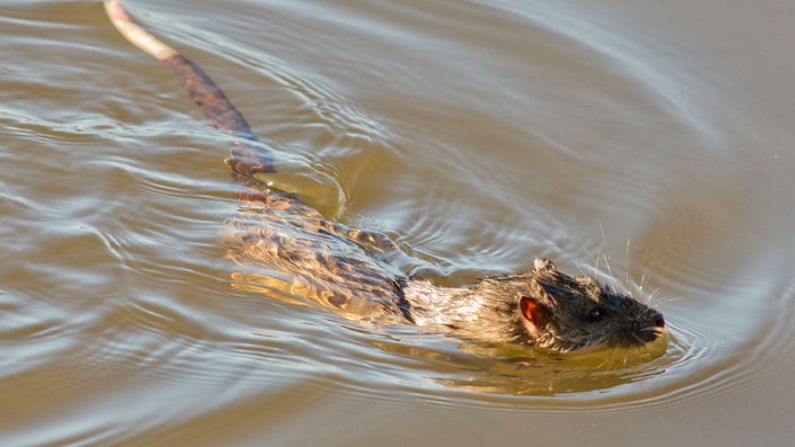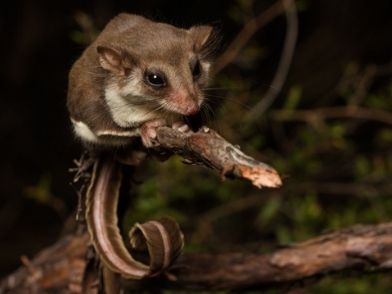Rakali
© Neil Andison
The rakali (Hydromys chrysogaster) — also commonly known as a water rat — is a unique, semi-aquatic native rodent. Shy and nocturnal, they are identifiable by their large size (similar to a platypus) and white-tipped tail. The rakali is the largest member of the Australian native rodent family but unlike most rodents, they spend much of their time in or near the water.
Quick facts
COMMON NAME:
Rakali
SCIENTIFIC NAME:
Hydromys chrysogaster
FAMILY:
Muridae
ALSO KNOWN AS:
Water rat, rabe, ‘Australian otter’
CONSERVATION STATUS:
Queensland: Least Concern
National: Least Concern
How we are helping rakali
In 2024, Wildlife Queensland’s PlatypusWatch Network was awarded a grant from the Brisbane Airport Community Giving Fund to support a new project aimed at raising awareness of the rakali and inspiring community stewardship to actively participate in local waterway conservation activities. In addition, since 2009, Wildlife Queensland has campaigned for a ban on enclosed opera house-style nets in Queensland.

Did you know?
The rakali is one of Australia’s only mammals to safely enjoy a meal of the highly toxic cane toad. Intelligent and resourceful, the water rat flips the toad over to avoid the poisonous glands found on the back of the toad’s neck and uses surgical-like precision to neatly remove the heart, liver, and toxic gall bladder before eating the rest.
 © Judith Deland/Flikr
© Judith Deland/Flikr
Threats to the rakali
- Human impact on habitat and food sources:
- Waterways are under threat from dam construction, riverbank erosion, irrigation, chemical pollution and garbage.
- Rakali are vulnerable to being caught in enclosed yabby traps (opera house nets).
- Predation by introduced species, including foxes and cats, as well as some native birds of prey.
- Large changes in their habitat, usually resulting from droughts, floods or habitat degradation, can result in localised declines in rakali populations.
Home range
- Normally between 1 and 4 kms of a waterway.
Distribution
- Found near waterways throughout Australia in New South Wales, Queensland, Tasmania, South Australia, far north and southwest Western Australia, the Northern Territory, and Victoria.
- The rakali is also found in Papua New Guinea and Indonesian West Papua.
Description
Shy and nocturnal, the rakali is the largest member of the Australian native rodent family. Although often confused with a land rat, the rakali behaves more like the platypus.
- Black to brown fur with an orange to white belly, and a dark tail with a white tip.
- Waterproof fur that dries quickly once on land.
- Elongated body shape which is perfectly adapted to glide through the water.
- Small ears that can be folded against its head.
- Whiskers that surround the face, which are highly sensitive and help it to forage underwater at night.
- Partially webbed hind feet.
- Can grow up to 70 cm in length from nose to tip of the tail and weigh a little over a kilogram (about the size of an adult platypus).
Signs
- A distinctive V-shaped wake in the water when swimming along the edges of waterways.
- Grass-lined nests at the entrance to burrows, usually hidden among vegetation on low banks of waterways.
Habitat
- Suited to both saltwater and freshwater environments, rakali are found throughout Australia. Commonly found in freshwater streams, creeks, lakes and rivers. They also inhabit coastal mangrove habitats, brackish estuaries and sheltered ocean beaches.
- Require healthy riparian vegetation and solid river banks, with minimal erosion.
- Live within burrows on the low banks of waterways.
Ecology
Life history and behaviour
- 2-3 years average life span in the wild.
- Mostly solitary and territorial.
Breeding
- 2 to 4 pups in an annual litter between spring and summer.
Food
- Nocturnal hunters, they eat a varied diet including: fish, aquatic insects, aquatic plants, crayfish, clams, mussels, crabs and even water birds and their eggs, frogs, and turtles.
- Rakali eat fungi and help to spread the fungi spores throughout the soil through their droppings. These spores then allow native plants to extract water and nutrients such as phosphorous and nitrogen from the soil in which they grow.
- They consume their prey on flat feeding sites such as logs, rocks or sheltered areas on the river bank, returning to these sites for each meal.




